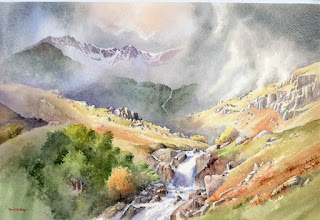I’ve just returned from running a sketch & walk course in the Lake District with a lovely group of students, where the biggest problem was a lack of water! This is something which is rarely encountered in Lakeland, and it did confound attempts to sketch certain waterfalls rather devoid of water. Still we had a great time and at least we eventually found some in Coniston Coppermines Valley.
 The watercolour on the right is the view we painted, though I actually did this three years ago during autumn when there was more water in the beck, and the hillsides were alive with warm colours. This also happens to be on the cover of the summer issue of Leisure Painter magazine, featured in an article on creating wisps of cloud and streamers, which can so enhance your work. It was painted on Saunders Waterford rough 140 lb paper, and to achieve the soft misty edges I scrubbed with a damp half-inch flat brush. Losing ridges and parts of a hill or mountain can add so much mood and mystery to a landscape, and the article covers various ways in which you can achieve these effects.
The watercolour on the right is the view we painted, though I actually did this three years ago during autumn when there was more water in the beck, and the hillsides were alive with warm colours. This also happens to be on the cover of the summer issue of Leisure Painter magazine, featured in an article on creating wisps of cloud and streamers, which can so enhance your work. It was painted on Saunders Waterford rough 140 lb paper, and to achieve the soft misty edges I scrubbed with a damp half-inch flat brush. Losing ridges and parts of a hill or mountain can add so much mood and mystery to a landscape, and the article covers various ways in which you can achieve these effects.
These softening-off techniques are a common feature in my books, especially the Winter Landscapes in Watercolour and Skies, Light & Atmosphere in Watercolour. Some artists feel that a standard broad-washed blue or grey sky can fit any landscapes, but I put great effort into my skies to introduce exciting and interesting cloud and atmospheric effects that suit a particular landscape, so there are a great many examples of these in both books.
In Lakeland my biggest problem with the students was keeping up with the three octogenarian ladies, one of whom was leaping up and down precipitous slopes like an over-active monkey. What a great pleasure it is to see people respond so well to the beauties of nature.




